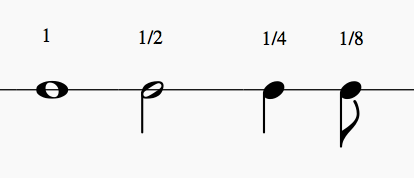Pitches need duration
So... Two weeks ago I told you how to read notes. For a quick recap: the clef shows you the reference note, and then "up" in paper means the next note on the scale (A-B-C-D-E-F-G or la-si-do-re-mi-fa-sol), and "down" means the previous one. Easy!
But music isn't only the pitch of the sounds. You've probably noticed some of them last longer than others. The duration of syllabes makes the "rhythm" of languages, which make them pleasant to hear even if you don't understand them. A good speaker knows how to make some syllabes last longer than other, to emphasis the content of what they're saying. You know who mastered the art of speaking? These guys:

Source
Damn yeah, the greeks! Some believe their speech was very characteristics and frequently noted as some syllabes having double the duration of others. We humans put a lot of effort into making things "mathematically squared", with fixed duration. Order tranquilizes us, makes us feel in control. As the Joker says:
Nursery rhymes are an easy example of how we tend to make things "squared". Take this one for example:
Twinkle twinkle little star, how I wonder what you are.
If you say it out loud, you'll easily get which syllabes last twice as long: "star" and "are", the last ones. Let's try writing it.

.png)
You got it by now. Blank notes (half notes) last twice as long as filled notes (quarter notes). Take the stem out of the half notes and BANG, you got whole notes which last even longer: twice the half notes! But what if I want a note that lasts less than the quarter notes ♩? Just draw a scumbag hat and you get a eighth-note or crotchet ♪
Confused? I'll put them in order:

Much easier now! The name of the durations actually comes from this.
- "a quarter-of-the-big-fat-stemless-white-note" =♩.
- "an eighth-of-the-big-fat-stemles-white-note" = ♪
- etc etc etc

Hierarchy
I'll take the previous example and translate the lyrics to my native language, which hopefully you'll not understand:

In such situation, or if there were no lyrics at all, how would you know where each phrase starts? Western languages mark the beginning of words and phrases with spaces, punctuation, capital letters, properly ordering them into an understandable design.

The same needs to happen with western music notation, where durations are properly ordered into what we call "measures". The space between big stems like this one: | . We also order them according to how they feel, and that's something no one will ever be able to explain to you. We hierarchize music according to where we "feel" the downbeats, where the drummer usually kicks the bass drum in a rock band.
Western music is so boring that we usually keep the same "law" throughout the pieces, and we usually put 2, 3 or 4 "syllabes" in each measure. In the beginning of a piece the musician writes how many syllabes he's going to fit in each measure, and how long are those syllabes:

--> This one means that in each measure we fit two quarter-notes. You won't see this written with a real quarter-note below the number: this is an adaptation made by a random bloke named Zoltan Kódaly which happens to be an absolute GOD for music educators. His pedagogical work is the work of a true absolute genius of his time and it some of his concepts are still applied today.
Usually, instead of the actual quarter-note, you'd write the number 4, because quarter-note. If you sing "twinkle twinkle little star" many times you'll feel the downbeats each 4 quarter-notes.

Some dances such as the waltz are usually in 3/4 time, meaning each downbeat is followed by two upbeats. We dance it just like that: one big step, two small steps. But driving a little bit away from classical ancient music, sure we get much more interesting hierarchies! A nice example is Pink Floyd's "Money", in 7/4 time (Roger Waters marks clearly 7 beats with his bass: try hearing and counting to 7! you'll feel the downbeat right in your heart):
Some heavy metal bands love to mess with downbeats as well, scrambling everything up. Here are Dream Theater playing a nice 4/4 riff and changing to a nice complex 7+8/8 beat when James LaBrie starts singing:
Sure classical music has many examples of uncommon hierarchies as well, the most famous being Stravinsky's ballet "The Rite of Spring", which was so hard to dance that it's legendary choreogapher Nijinsky started screaming numbers to the dancers, as the audience bursted into a violent riot, throwing stuff at the poor musicians, already struggling to read such hellish rhytmical measures. Damn... uncle Stravinsky did really shook things up.
That's it for today!
Any doubts?
Would you be able to combine notes with rhythms to make a true score of "twinkle twinkle little star?
Let me know in the comments section!

This post is my entry for Educator's Showdown Round 4 by @novili
Do you want to earn SBD forever? I'm giving away 1 Steem Basic Income share :) Just drop an original comment in this post!
If you enjoyed this post please consider:



Do you want to earn SBD forever? I'm giving away 1 Steem Basic Income share :) Just drop an original comment in this post!
If you enjoyed this post please consider:



